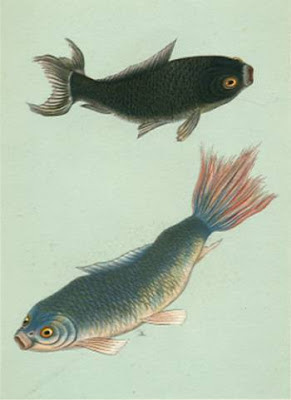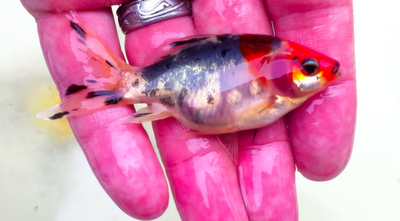Article 1 Particular matters of concern
1. Overall fish shape and balance
Basic shape of the fish is defined mainly by the characteristics of the head, torso and tail and their balance relative to each other.
2. Fish to be thick and sturdy.
Thicker and sturdier fish to be graded as superior when judging in proportion to size of fish.
3. Scales to be neatly lined with beautiful colour and lustre.
Scales neatly lined, and small in proportion to the body of fish to be graded as superior. For colour and lustre, regardless of Aka (red) or Sarasa (calico) breeds, fish with deep reds, gold colours and healthy colours to be graded as superior. Shiro (white) and Sarasa breeds shall also be graded with such criteria.
4. The fish to be as graceful as possible.
5. Fish maintaining noble grace to be regarded as superior.
6. Swimming of the fish to be light.
Swimming gait of fish must be elegant, with light wagging of tail resulting in fluid movement.
Article 2 Comparison of the way of viewing the fish is as follows.
1. Head: To have spacing between eyes, and much Nikukobu in front of eyes, with variety of Tokane, Kamicho, Ryuutou etc.
2. Back: To have a broad back with a gentle slope and adequate roundness.
3. Stomach: To be well-positioned as a whole with the back and spaced adequately from the tail.
4. Pipe of tail: To chose the fish with tail pipe of more roundness and robustness in proportion to the breadth of the back, with roundness apparent at the joint of the tail.
5. Tail: Neck of tail to be beautiful with bilateral symmetry in its maegakari (the “M” tips of the tail) and with adequate ozara (bottom scales around tail) and obari, with skilful swimming. Applies to Mitsuo, Sakurao, Yottsuo etc as well. The tail must not exceed approximately 90 degrees in relation to the tail pipe nor rise up over the back.
6. Fins: Necessary to have uniformity in movement and size for each fin. Rudder fins to be judged equally regardless of single fin or double fins.
Article 3
Size of fish must not be taken into consideration for judging.
Article 4
Fish are to be judged as according to their quality on that particular day.
Supplementary provisions names of colours are designated as below.
1. Red section....Kiniro, Niiro, Shoujou
2. White section...Shiro, Giniro
3. Sarasa section....Taseki sarasa, Tashiro sarasa, Koshijiro, Seaka, Shirohara pattern
4. Head pattern....Omoyaburi, Omoshiro, Omosarasa, Tanchou, Ryoudo, Kuchibeni, Mado, Ougashira
Article 5
There can be cases of no judgement if the respective defects below are excessive.
1. No judging of fish with dorsal fin, double tail or deformities
2. Unevenness of back, curved kobu or tail pipe
3. Pinced, closed, irregular, curled, stripped tail
4. Extrusion of rudder fin, upwards tilt of head, downwards tile of head, one-sided tilt of tail, covered eyes, protruding eyes, indented eyes
5. Sick fish
Article 6
Obese or juvenile fish to the point of lacking grace and poise shall be counted as objects for demerit.
Article 7
Prizes will be revoked in the case of fabrication of age of fish exhibited.



































































